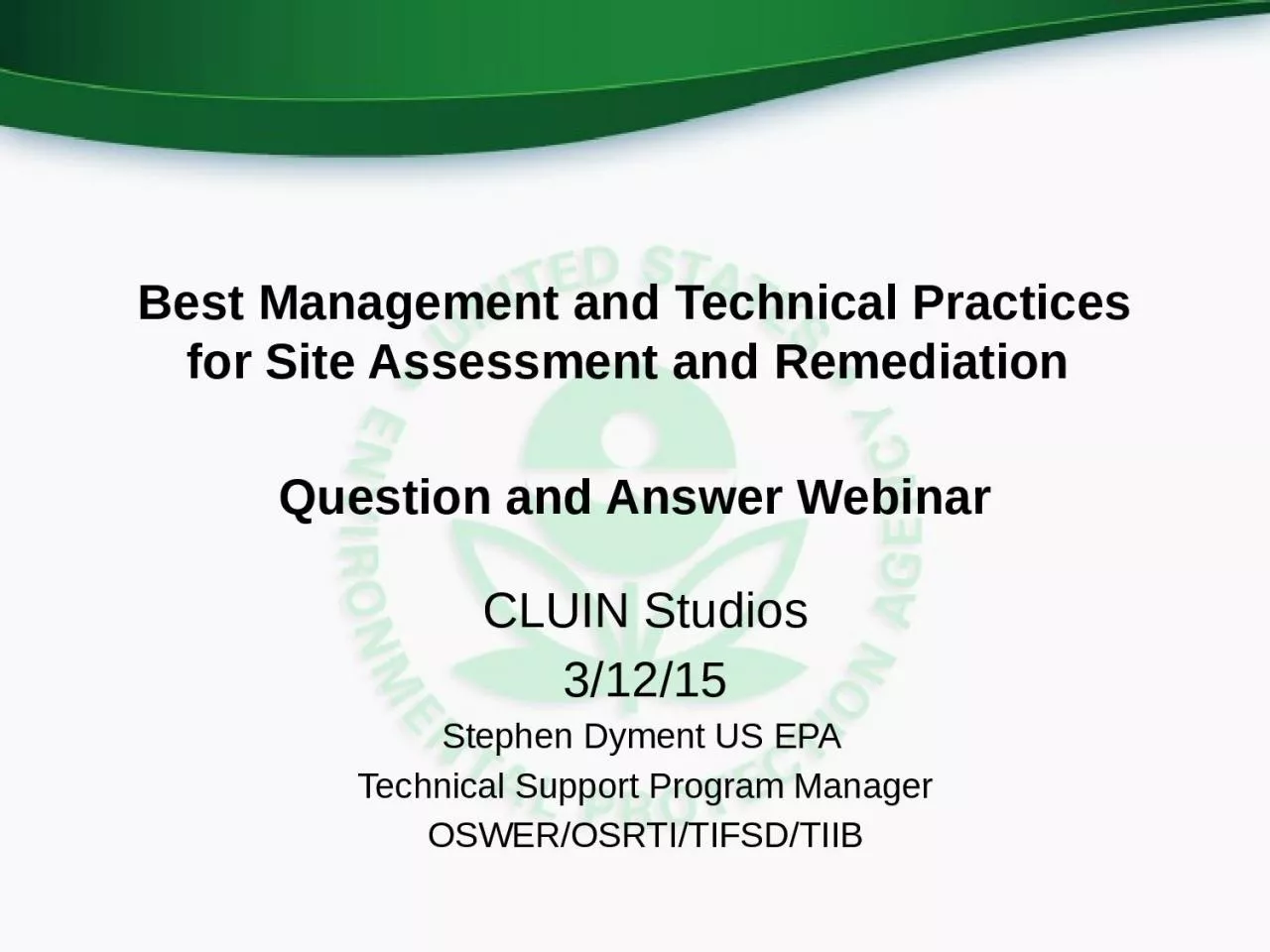

Question and Answer Webinar CLUIN Studios 31215 Stephen Dyment US EPA Technical Support Program Manager OSWEROSRTITIFSDTIIB QampA Session for Archived Webinars Best Management and Technical Practices for Site Assessment and ID: 917253
Download Presentation The PPT/PDF document "Best Management and Technical Practices ..." is the property of its rightful owner. Permission is granted to download and print the materials on this web site for personal, non-commercial use only, and to display it on your personal computer provided you do not modify the materials and that you retain all copyright notices contained in the materials. By downloading content from our website, you accept the terms of this agreement.
Slide1
Best Management and Technical Practices for Site Assessment and Remediation Question and Answer Webinar
CLUIN Studios
3/12/15
Stephen Dyment US EPA
Technical Support Program Manager
OSWER/OSRTI/TIFSD/TIIB
Slide2Q&A Session for Archived Webinars
Best Management and Technical Practices for Site Assessment and
Remediation
Delivered at 2013 National Tanks Conference CLUIN archive sessions in 2014 Links http://www.clu-in.org/conf/tio/bmp/intro.cfm http://www.clu-in.org/conf/tio/bmp/archive.cfm http://www.clu-in.org/conf/tio/bmp/archive.cfm
3/11/15
U.S. Environmental Protection Agency
2
Slide3Topic Review BMPs for Characterization
Why?
Optimization history, common findings, pilots
Identification of BMPsSystematic PlanningCSMs, lifecycle costs and scale for LUST sites Collaborative data and high resolution toolsGeophysical, hydrostratigraphic, direct sensingDMAs, monitoring wells, vertical profiling, transects, flux3/11/15
U.S. Environmental Protection Agency
3
Slide4Topic Review BMPs for
Remediation
Why?
Optimization history, common findingsIdentification of BMPsCSMs for designEvolution of remedy implementationSingle, large scale, presumptive to targeted multi technology approachesHRSC and completion strategiesTechnologiesSVE, air sparging, ISCO, excavation, bio/ enhanced bio, MNAGreen remediation, sustainability considerations
Case Studies
3/11/15
U.S. Environmental Protection Agency
4
Slide5Submitted Questions Part 1Are these BMPs codified anywhere?
Are they part of EPA or state official guidance?
3/11/15
U.S. Environmental Protection Agency
5
A set of methods or techniques found to be the most effective and practical means in achieving an objective while making the optimum use of resources
Slide6Submitted Questions Part 1How long ago were you doing 10 sites per year compared to 30 per year now?
Is this increase mostly attributed to this optimization?
What is not included, specifically in this optimization?
3/11/15U.S. Environmental Protection Agency
6
Slide7Submitted Questions Part 1What’s an evolving Conceptual Site Model?
Does this mean I need special software?
Or need to recreate a CSM every month?
3/11/15U.S. Environmental Protection Agency
7
Slide8Submitted Questions Part 1Do you have examples of CSMs you can share?
What makes for a “good” CSM?
3/11/15
U.S. Environmental Protection Agency
8
Slide9Submitted Questions Part 1Usually more data for a site means more time and/or more money.
How can I balance the increased emphasis on characterization with costs?
3/11/15
U.S. Environmental Protection Agency9
Slide10Example BTSC Technical Support Projects
South Dakota Triad- 2004/2005
5 “legacy” UST sites, 3 active gas stations, 1 closed gas station , 1 railroad fueling station
Stakeholders: South Dakota PRCF, State DENR, property owners/consultants, vendorsGoals: rapid characterization, accurate CSMs, establish clear cleanup goals, move to closureResultsElevated communication: PRCF and DENR1 day systematic planning meeting, 2 week field effortCorrective action plans for all 5 sites developed
3 previously unknown USTs located & removed350,000 MIP data points25 soil, 13 groundwater, 1 product lab samples analyzed1 NFA, 2 additional remediation/vapor mitigation compliance monitoring, 2 MNA
Slide11Submitted Questions Part 1
Can you give me examples of "non-technical uncertainties" you run into often when using systematic planning?
3/11/15
U.S. Environmental Protection Agency11
Slide12Part 1 Live Session Questions
3/11/15
U.S. Environmental Protection Agency
12
Slide13Submitted Questions Part 2Everyone starts a site with the optimistic goal of cleaning it up… completely. After decades of remediating, we have contaminants that just won’t go away. How do you start the dialog to revisit your site goals to get to closure?
3/11/15
U.S. Environmental Protection Agency
13
“Everybody has a plan… ‘till they get punched in the mouth.
-Mike Tyson
http://
www.epa.gov/oust/cat/backlog.html
Slide14Submitted Questions Part 2
What would you say is the minimum time required to prepare
reasonable performance metrics for a remediation system? Would a three year clean up average allow for the time needed to make decisions based on performance metrics?3/11/15U.S. Environmental Protection Agency
14
-Technology dependent
-Type and frequency of data
Slide15Submitted Questions Part 2
When is it time to consider pulsing an SVE system?
3/11/15
U.S. Environmental Protection Agency15
http://www.clu-in.org/download/techfocus/sve/PNNL-21843.pdf
Slide16Submitted Questions Part 2
These technologies are too expensive for my small UST site. How do I make them work for me?
3/11/15
U.S. Environmental Protection Agency16
-Good CSM-
Timely optimization-Scalability of most cleanup technologies
Slide17Submitted Questions Part 2
Have you used Green Remediation at an UST site?
3/11/15
U.S. Environmental Protection Agency17
http://www.clu-in.org/greenremediation/subtab_d38.cfm
Slide18Submitted Questions Part 2
Doesn’t bio take a while to develop the right bug communities?
Seems like other technologies could clean up much faster at a small UST site
3/11/15U.S. Environmental Protection Agency
18
Slide19Part 2 Live Session Questions
3/11/15
U.S. Environmental Protection Agency
19
Slide20Summary & Wrap Up
3/11/15
U.S. Environmental Protection Agency
20
Slide21UST Case Studies Sought
If you have an UST site that can serve as a case study, please share it with us!
Case studies can range from 1 page to 100+ pages depending on the site and resources
Typical elements of a case study includeSite InformationContaminants and exposure pathwaysPerformance DataCost DataContact Queenie Mungin-Davis at Mungin-Davis.Queenie@epa.gov
Slide2225th National Tanks Conference and ExpoSeptember 14 – 16, 2015 in Phoenix, AZ
Additional OUST training will be offered
Register at
http://www.neiwpcc.org/tanksconference/
Slide23Online UST Forum Available
NEIWPCC
(OUST Grantee) welcomes LUST/UST stakeholders to participate in the Corrective Action Planning Team and LUST Corrective Action
Forumhttp://www.neiwpcc.org/ust/caforum/index.phpFor more info, contact JHarrison@neiwpcc.org or Queenie Mungin-Davis, mungin-davis.queenie@epa.gov
Slide24Thank you!Steve Dyment
, U.S. EPA Technology Innovation and Field Services
Division
(dyment.stephen@epa.gov)Queenie Mungin-Davis, U.S. EPA OUST Coordinator (mungin-davis.queenie@epa.gov)